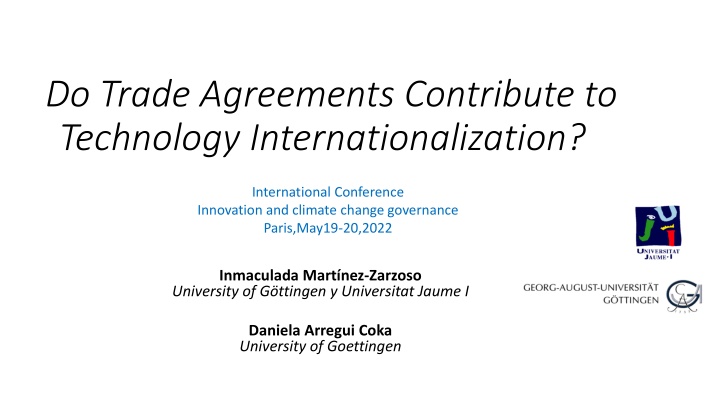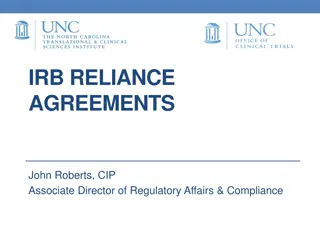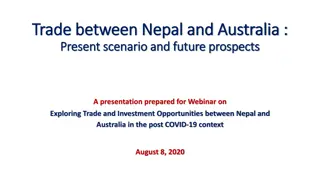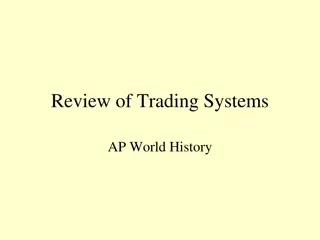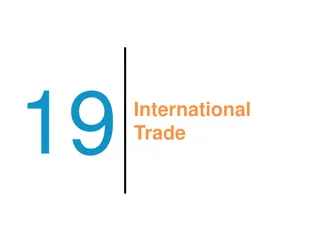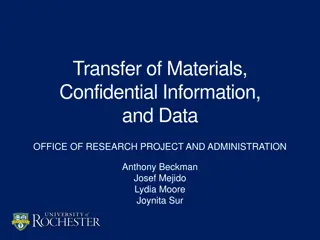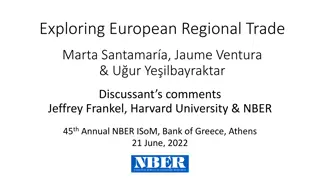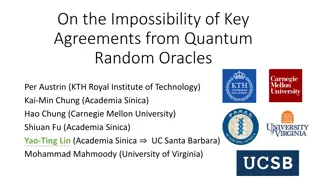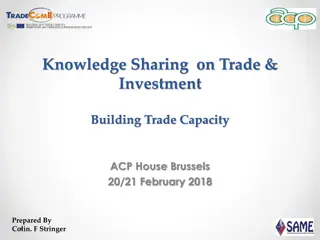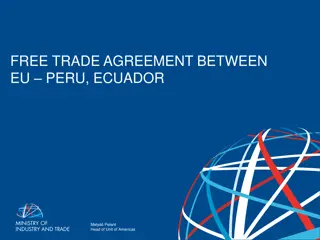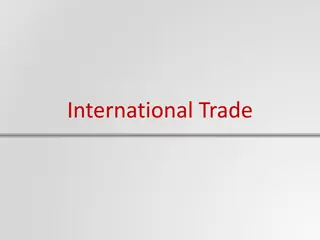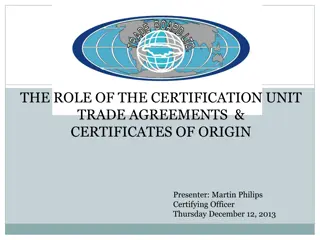Trade Agreements & Technology Internationalization: Role of DCFTAs
This paper delves into the impact of Deep and Comprehensive Free Trade Agreements (DCFTAs) on technology internationalization, highlighting the significance of technology provisions, geographical and institutional distances, and the WTO Agreement on TRIPS. Using a gravity model, it analyses the relationship between trade agreements and technology transfer, providing insights into the effects of FTAs on firms' technology internationalization.
Download Presentation

Please find below an Image/Link to download the presentation.
The content on the website is provided AS IS for your information and personal use only. It may not be sold, licensed, or shared on other websites without obtaining consent from the author.If you encounter any issues during the download, it is possible that the publisher has removed the file from their server.
You are allowed to download the files provided on this website for personal or commercial use, subject to the condition that they are used lawfully. All files are the property of their respective owners.
The content on the website is provided AS IS for your information and personal use only. It may not be sold, licensed, or shared on other websites without obtaining consent from the author.
E N D
Presentation Transcript
Do Trade Agreements Contribute to Technology Internationalization? International Conference Innovation and climate change governance Paris,May19-20,2022 Inmaculada Mart nez-Zarzoso University of G ttingen y Universitat Jaume I Daniela Arregui Coka University of Goettingen
Motivation Since the emergence of GVC innovation activities increasingly organized at an international level Lower information and communication costs led to seek technological resources beyond national borders Through the process of technology internationalization firms gain access to more advanced technologies and larger pools of knowledge Deep and Comprehensive Free Trade Agreements (DCFTA) have been used to tackle issues related to innovation, technology transfer and IPR issues
Questions in this paper Do DCFTAs contribute to technology internationalization? What role do technology provisions play? How important are geographical and institutional distances? Role of the WTO Agreement on Trade-Related Aspects of Intellectual Property Rights (TRIPS)
What we precisely do is Estimate a gravity model of technology internationalization using a panel of 6,480 country pairs of high- and middle- income countries for the period 1980-2015 Proxy for technology internationalization: Patent statistics of foreign inventions owned by domestic firms Poisson Pseudo Maximum Likelihood (PPML) estimator to estimate the effect of FTAs (differentiating by their technology-related provisions), geographical and institutional distance on technology internationalization
Preview of the Results First, trade agreements lead to a significant increase in the technology internationalization of firms: After ratification, this effect increase when the implementation and enforcement are completed Second, FTAs in trade and services have a positive effect on technology internationalization Third, countries that are geographically and culturally closer, exchange more technology and knowledge Finally, the effects are heterogeneous: level of income/level of integration
Outline Literature Review Technology Provisions in Trade Agreements Data, Model and Estimations Main Results Conclusions Next Steps
Literature Review Direct effect: FTAs technology internationalization Peri, 2005: Cross-sectional gravity-like model to explain patents granted by the US patent office (and citations) between 1975 and 1996. 147 subnational regions in Europe and North America Picci, 2010: Cross-border ownership, co-ownership and co-inventions flows between 1995 and 2005, for 42 countries, considers the EU membership Montobbio & Sterzi, 2013: Focus only on the determinants of co-inventions new technologies that have been created by inventors of different countries between developed and emerging countries -- between 1990-2007, network analysis De Prato & Nepelski, 2014: Also focus on co-inventions. Using patent data from the PATSTAT database, estimate a gravity model of co-inventions registered in 90 patent offices around the world over the period 1990-2007 Jinji et al., 2019: Patent citations as proxy for technology spillovers, find positive effects of FTAs on the number of patent citations. Sample: 1991-2007, 114 countries Santacreu, 2022: Focus on the dynamics of international technology licensing in the context of FTAs with technological provisions Sample: 1995-2012, 41 countries
Technology Transfer Through Trade Indirect Effects: FTAs increase trade, trade increase knowledge flows Campi and Due as, 2019: Focus on aggregate trade and FTAs with and without IPR provisions. No controls for multilateral resistance Mart nez-Zarzoso and Chelala, 2021: Global sample of countries and broader set of technology-related provisions and sectoral trade. Heterogeneous effects Maskus and Ridley, 2021: Investigate whether FTAs with IPR chapters that exceed the requirements of the TRIPS agreement have an additional impact on sectoral exports IPR-related FTAs with USA, EU or EFTA, have a significantly positive effect on exports to third countries in high-technology goods Erixon, Guinea et al., 2022: Explore the link in EU FTAs between IP provisions and trade. (+) effect of FTAs with IP prov on exports IP-intensive goods. Marginal (-) effect of FTAs with IP prov on exports non-IP-intensive goods.
Technology Provisions in Trade Agreements: Types 1. Intellectual Property Rights: Implies ratification of international treaties or conventions not referenced in the TRIPS. 2. Data Protection Includes exchange of information and experts, and promotes joint projects between member states. 3. Innovation Policies: Fosters participation in framework programs and promotion of technology transfers. 4. Information Society Relates to exchange of information, the dissemination of new technologies, training as well as cooperation and exchange of information in the context of other policies. 5. Research and Technology: Promotes joint research projects, exchange of researchers, and the development of public-private-partnerships.
Free Free Trade Agreements and Tech Trade Agreements and Tech- -provisions provisions Total FTAs in the sample 179 FTAs with at least one technology related provision 141 FTAs with zero provisions 38 FTAs according to type of provisions: Intellectual property rights 111 Data protection 31 Information society 72 Innovation policies 27 61 Research and technology Note: The total number of provisions exceed the total number of FTAs since an agreement can include more than one technology-related provision. Source: Hoffman et al. (2017) & WB.
Agreements Containing All Types Agreements Containing All Types Most of the agreements that mention all types include European Union (13), followed by China(10), South Korea (4), and the United States (3) 13 13 6 4 3 OTHERS EU CHINA KOREA UNITED STATES
Agreements with No Technology Provisions Agreements with No Technology Provisions 29 are between Latin American countries 9 are between India and other developing countries 5 between the EU and others 29 19 9 5 LATIN AMERICA OTHER INDIA EU
Model Specification Gravity model, widely used to predict bilateral flows between countries, is nowadays considered to be a structural model with solid theoretical underpinnings (Anderson, 1979; Bergstrand, 1985; Eaton and Kortum, 2002; Anderson and van Wincoop, 2003; Feenstra, 2016; Allen, Arkolakis, and Takahashi, 2014; Keith and Head 2014; among others). For technology internationalization (Peri, 2005; Santacreu, 2022) ?+ ?1????????+?1????????+?2?????????? ????= ???[???+ ???+ ??????_???? (1) +?3ln??????????+ ?4????????] ???? (2) ?+ ?2????????] ???? ????= ???[???+ ???+ ??? + ??????_???? (3) ?+ ?3????????] ???? ????= ???[???+ ???+ ??? ? + ??????_???? ???? is the count of patents for DOFI calculated for the country pair ? (owner) and ? (inventor) with ? ?. The bilateral number of patents depend on bilateral factors, ???, as well as on country-time-specific fixed effects, ??? and ???that act as multilateral resistance terms (MRT). (3) add bilateral-specific time trends, ??? ?
Variable Description No. Obs. Mean Std. Dev. Min Max DOFI Patent count of an invention of country ? owned by a firm of country ? 233,280 2.663 29.098 0 1450 Summary Statistics FTA 1: country pair is member of the trade agreement at year t 0: otherwise 233,280 0.135 0.342 0 1 FTA_prov 1: country pair is member of the trade agreement with one or more technology-related provision at year t 0: otherwise 233,280 0.112 0.315 0 1 FTA_zprov 1: country pair is member of the trade agreement without technology-related provisions at year t 0: otherwise 233,280 0.024 0.152 0 1 Depth indicates the degree of inclusiveness in terms of provisions covered D r et al. (2014) Depth =0-7 Full FTA 0,1 Services prov. 0,1 Investment 0,1 General standards 0,1 Public procurement 0,1 Competition 0,1 IPR 0,1 Depth Interaction variable between dummy variable FTA and depth index 233,280 0.305 1.163 0 7 Ln (distance) Ln of geographical distance in km between country ? and country ? 227,520 8.480 0.970 4.088 9.892 Border 1: countries are neighbors 0: otherwise 227,520 0.031 0.173 0 1 Language 1: countries have the same official language 0: otherwise 1: countries share colonial past 0: otherwise 227,520 0.087 0.282 0 1 Colony 227,520 0.022 0.148 0 1 TRIPS 1: country pair complies with the TRIPS at time t 0: otherwise 233,280 0.106 0.308 0 1
Technology internationalization by income group Note: Cross-border ownership measured as the domestic ownership of foreign inventions. Low-income countries not included because of lack of data. Source: International co-operation in patents (OECD, 2020)
FTAs provisions by income level of member countries FTAs provisions by income level of member countries Bilateral and regional trade agreements in force since or after 1980, classified according the income level of the member states and technology content. HH: FTA among high income countries; HL: FTA among high income and low middle- income countries. HU: FTA among high income and upper middle-income countries; UU: FTA among upper middle- income countries; LL: FTA among low middle- countries; andUL:FTA among upper and low middle- countries. Source: Hofmann et al. (2017).
Baseline Baseline Results Results Owner-year, creator-year FTA effect Owner-year, creator-year FTA_depth O-Y & C-Y & Pair Fixed effects FTAt+1 (1) (2) (3) (4) 0.02 (0.043) - - - - - - - - 0.022 (0.037) - - 72,613 0.982 FTA 0.218*** (0.0253) -0.0480*** (0.0119) 0.599*** (0.0233) 0.451*** (0.0232) -0.00289 (0.0345) 0.106*** (0.0228) - - 124,203 0.946 0.328*** (0.0266) -0.00580 (0.0125) 0.632*** (0.0231) 0.483*** (0.0231) -0.0487 (0.0344) 0.213*** (0.0251) -0.0833*** (0.00690) 124,203 0.945 0.192*** (0.0298) -0.0361*** (0.0121) 0.602*** (0.0238) 0.454*** (0.0240) -0.00283 (0.0355) 0.0773** (0.0305) 0.0725* (0.0383) 119,523 0.946 - FTAs increase Technology internationalization by about 24 % (1) Ln (distance) Border Language - FTA effect (+) for shallow agreements, but (-) for deeper agreements>5 Prov.(2) - Does not seem to be endogenous (3) - FTA effect vanishes when pair FE are included (4) - Heterogeneous effects? Colony TRIPS FTA_depth/FTAt+1 Observations R-squared Park-type Test p- values GNR p-values 0.000 0.000 0.000 0.000 0.184 0.176 0.089 0.005 Note: Standard errors in parentheses. Significance level * p<0.1, ** p<0.05, *** p<0.01. Dependent variable DOFI. Clustered standard errors at country pair. Estimation using the ppml_panel_sg command in Stata (Larch et al., 2019). Park-type Test: null hypothesis states homoscedastic errors. GNR denotes Gauss-Newton Regression: null hypothesis states CVMR assumption for the functional form of the variance. O-Y &C-Y refers to owner-year and creator-year FE as proxies for Multilateral Resistance. Pair refers to bilateral (owner-creator) fixed effects.
Results for different levels of integration Model with pair FE and MRT (Eq.2) Model with gravity variables and MRT (Eq.1)
Results by level of integration with tech-prov Model with pair FE and MRT (Eq.2) Model with Gravity variables and MRT (Eq.1) _zprov=zero technology provisions; _tprov= at least 1 technology provision
What provisions are relevant for EIAs With pair FE and MRT With gravity variables and MRT ipr=Intellectual Property Rights; datap=Data Protection; inpo=innovation policies; ifso=Information Society; rt=research and technology
Heterogeneity: Results by income group, FTA effect With gravity variables and MRT With pair FE and MRT HH= owner high income, inventor high income HM= owner high income, inventor upper- or lower-middle income MH= owner upper- or lower-middle income, inventor high income MM= owner and inventor upper- or lower-middle income
Heterogeneity: Results by income group, other factors Geographical distance Institutional distance With gravity variables and MRT
Heterogeneity: Results for EIAs by provision type ipr=Intellectual Property Rights; datap=Data Protection; inpo=innovation policies; ifso=Information Society; rt=research and technology HH= owner high income, inventor high income HM= owner high income, inventor upper- or lower-middle income MH= owner upper- or lower-middle income, inventor high income With pair FE and MRT
Robustness & further research Estimations with multi-clustering and pair-trends (Eq. 3) Phasing-in effects (higher effects after 5, 10 and 15 years of ratification) Co-inventions as dependent variable, controlling for trade, results hold Next steps: Provisions effect changes over time Enforcement: Treaties must take these provisions into account but enforcement is also important Innovation gap: Estimate what are the direct effects (due to technology transfer) and indirect effects (through trade) of the FTAs with provisions on the innovative and technological capacity of the countries that ratify these agreements
Robustness I: Different clustering options, bilateral-trends PFE=pair clustering; MC=multiclustering; PTR=Pair trend
Fixed effects Time-Country Time-Country Results Results for in in effects effects Estimates of the gravity model for cross-border ownership flows sample of 81 countries and for the period 1980 to 2015 for phasing phasing (1) (2) 0.137*** (0.0286) 0.159*** (0.0361) 0.0531 (0.0346) 0.0384 (0.0381) -0.0345** (0.0142) 0.558*** (0.0268) 0.451*** (0.0255) 0.0413 (0.0385) 0.0134 (0.0288) 0.252*** (0.0305) 0.159*** (0.0357) 0.0452 (0.0341) 0.0181 (0.0373) 0.00294 (0.0145) 0.601*** (0.0270) 0.477*** (0.0253) -0.00561 (0.0386) 0.132*** (0.0319) -0.0794*** (0.00749) FTA FTA (t - 5) FTA (t - 10) FTA (t - 15) Ln (distance) Border Language Colonial TRIPS FTA_depth Observations 142,902 142,902 R-squared 0.964 0.966 Note: Standard errors in parentheses. Significance level * p<0.1, ** p<0.05, *** p<0.01. Dependent variable DOFI. FTA (t - 5), FTA (t - 10), FTA (t - 15) denote lags of the variable FTA of five, ten and fifteen years. Clustered standard errors, clustered at country pair. Estimation using the ppml_panel_sg command in Stata (Larch et al., 2019). Time-country fixed effect refers to time-varying country specific fixed effects.
Fixed effects Time-Country Time-Country Results Results for in in effects effects Estimates of the gravity model for co-invention flows sample of 81 countries and for the period 1980 to 2015 for phasing phasing (1) (2) FTA 0.143*** 0.101*** (0.028) (0.039) FTA (t - 5) 0.240*** 0.255*** (0.038) (0.039) FTA (t - 10) 0.163*** 0.164*** (0.04) (0.04) FTA (t - 15) -0.004 0.007 (0.032) (0.0326) Ln (distance) -0.093*** -0.093*** (0.009) (0.009) Border 0.698*** 0.701*** (0.019) (0.019) Language 0.469*** 0.471*** (0.021) (0.021) Colonial 0.133*** 0.130*** (0.023) (0.023) TRIPS 0.004 -0.025 (0.024) (0.03) FTA_depth - 0.03** - (0.015) Observations 142,902 142,902 R-squared 0.964 0.964 Note: Standard errors in parentheses. Significance level * p<0.1, ** p<0.05, *** p<0.01. Dependent variable DOFI. FTA (t - 5), FTA (t - 10), FTA (t - 15) denote lags of the variable FTA of five, ten and fifteen years. Clustered standard errors, clustered at country pair. Estimation using the ppml_panel_sg command in Stata (Larch et al., 2019). Time-country fixed effect refers to time-varying country specific fixed effects.
Conclusions Agreements with and without technology & innovation provisions increase technology internationalization For agreements with more than 5 non-trade provisions FTAs have lower effect The effects are heterogeneous: by depth and income group The effect differ by type of provision IPR provisions are important Countries that are geographically and culturally closer, exchange more technology and knowledge, these effects are also heterogeneous by income group
Many Thanks imartin@uni-goettingen.de @martinei1
Robustness: Different clustering options, pair- trends EIAs with tech prov TPR3=pair-clustering; TPR3Multi=multi-clustering; TPR3Trend=Pair-trends
Heterogeneity: Results by income group, TRIPS IG_H: TRIPS with gravity variables IG_H2: TRIPS with pair FE MH= owner upper- or lower-middle income, inventor high income
What provisions are more relevant for CUs With pair FE and MRT With gravity variables and MRT ipr=Intellectual Property Rights; rt=research and technology
Robustness: Different clustering options, trends Cus with Tech prov TPRCU=pair clustering; TPRCUMulti=multiclustering; TPRCUTrend=Pair trend
Fixed effects Time-Country (1) 0.284*** (0.04) 1.993*** (0.464) 0.679*** (0.087) 0.007 (0.032) 0.099*** (0.016) -0.029*** (0.008) -0.072*** (0.018) -0.052*** (0.008) -0.023* (0.013) 0.648*** (0.023) 0.419*** (0.025) -0.002 (0.036) 0.401*** (0.031) 124,203 0.947 Estimations Estimations by by Depth Depth FTA Depth 1 Depth 2 FTAS with D5-D7 provisions have a lower effect on technology internationalization Depth 3 Depth 4 Depth 5 Depth 6 D1: basic trade agreement D2: substantive provisions on services D3: includes provisions on investment D4: general standards D5: public procurement D6: competition D7: IPRs Depth 7 Ln (distance) Border Language Colony TRIPS Observations R-squared
Fixed effects Time-Country Time-Country (1) (2) 0.531*** 0.555*** FTA_zprov (0.0493) (0.0480) Estimation by Estimation by type of provision type of provision 0.125*** 0.299*** IPR (0.0399) (0.0507) -0.0379 -0.0847* Data protection (0.0499) (0.0494) Innovation policies 0.267* 0.309** (0.144) (0.130) Information societies -0.125 0.00539 IPR (+) Innovation policies (+) and research and technlology (+) (0.0829) (0.0848) Research & Technology 0.353*** 0.218*** (0.0405) (0.0478) -0.0170 -0.00592 TRIPS (0.0132) (0.0132) 0.633*** 0.658*** FTA_depth (0.0229) (0.0235) 124,203 124,203 No. observations R-squared 0.946 0.946 Park-type Test p-values 0.000 0.000 GNR p-values 0.190 0.179 Note: Standard errors in parentheses. Significance level * p<0.1, ** p<0.05, *** p<0.01. Dependent variable DOFI. form of the variance. Time- country fixed effect refers to time-varying country specific fixed effects.
(1) HH (2) HH (3) HH (4) HH Heterogeneous effects by income group VARIABLES FTA_tprov_HH 0.167*** (0.0242) 0.0997 (0.117) 2.450*** (0.207) 2.697*** (0.171) 0.447*** (0.0465) 0.285*** (0.0262) 0.416*** (0.102) 2.700*** (0.188) 2.840*** (0.165) 0.516*** (0.0443) 0.165*** (0.0242) 0.103 (0.117) 2.455*** (0.208) 2.704*** (0.171) 0.617*** (0.195) -0.188 (0.200) 0.0729 (0.281) 0.0500 (0.232) -0.0471*** (0.0119) 0.607*** (0.0231) 0.428*** (0.0237) 0.00672 (0.0347) 0.129*** (0.0223) 0.0420* (0.0250) -0.117 (0.120) -0.602*** (0.184) 0.00279 (0.246) -0.00455 (0.0951) FTA_tprov_HM FTA_tprov_MH FTA_tprov_MM FTA_zprov FTA_zprov_HH FTA_zprov_HM FTA_zprov_MH lndis -0.0457*** (0.0119) 0.609*** (0.0231) 0.427*** (0.0237) 0.00728 (0.0347) 0.128*** (0.0223) -0.00198 (0.0123) 0.643*** (0.0231) 0.468*** (0.0237) -0.0500 (0.0348) 0.241*** (0.0237) -0.0914*** (0.00708) 124,203 0.948 YES contig comlang_off colony trips 0.0151 (0.0224) FTA_depth Observations R-squared Country-time FE & pair 124,203 0.947 YES 124,203 0.947 YES 72,613 0.982 YES YES
